Catching up with Twilight
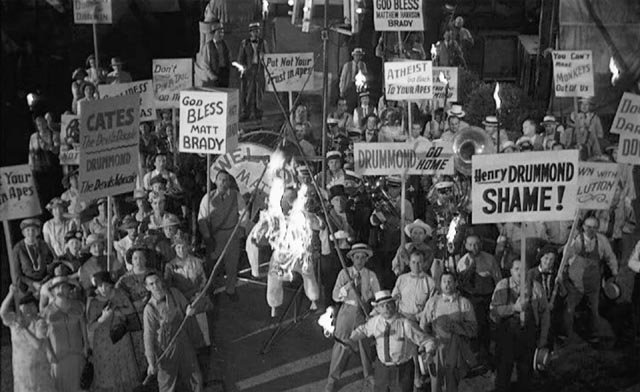
I’ve recently been dipping into my backlog of unwatched Twilight Time Blu-rays. While the label’s focus has always been on the score (most disks have isolated music tracks, with some of their commentaries focusing on composers rather than directors), what has struck me most strongly in my latest viewing is the quality of the acting, and the range of performance styles on display in titles ranging from 1960 to the late ’80s.
The biggest contrast is between the earliest movie, Stanley Kramer’s Inherit the Wind (1960) and the three later films, Ivan Passer’s Cutter’s Way (1981), James Foley’s At Close Range (1986) and Paul Greengrass’ Resurrected (1989), although there are notable variations among the latter three as well.
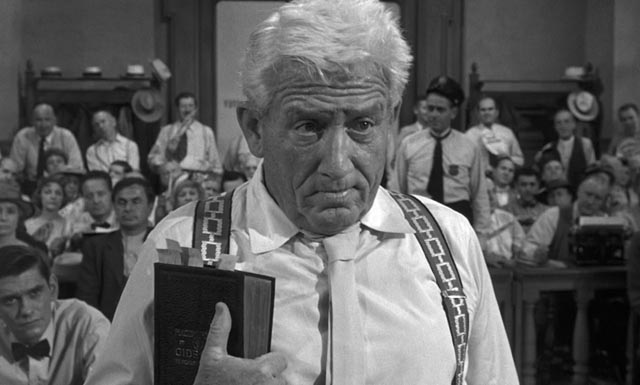
Inherit the Wind (Stanley Kramer, 1960)
Inherit the Wind, adapted from the 1955 play by Jerome Lawrence and Robert E. Lee, which in turn was based on the infamous Scopes Monkey Trial of 1925, belongs firmly to the traditions of classical Hollywood. The script is literary rather than cinematic and the direction and performances serve those literary intentions. Although shot in richly textured black-and-white by Ernest Laszlo, this is very much a theatrical movie, showcasing larger than life performances by stars who bring a wealth of experience to roles which are conceived as thematic types. With a script constructed to serve an argument which is conceived in almost Manichean terms, it becomes the actors’ task to infuse nuance and personality into the characters who carry all that thematic weight.
The two leads, Spencer Tracy as Henry Drummond and Frederic March as Matthew Harrison Brady, bring all of their personal on-screen history to the movie, turning the philosophical argument between science and belief into a drama of personal strengths and weaknesses. Drummond is brought to a small Southern town to defend high school teacher Bertram T. Cates (Dick York) who has been arrested for teaching Darwin’s theory of evolution in class – in violation of a state law which bans anything which contradicts the literal word of the Bible. The town brings in Brady to prosecute, an old friend and rival of Drummond’s who has in old age settled into a rigid fundamentalism.
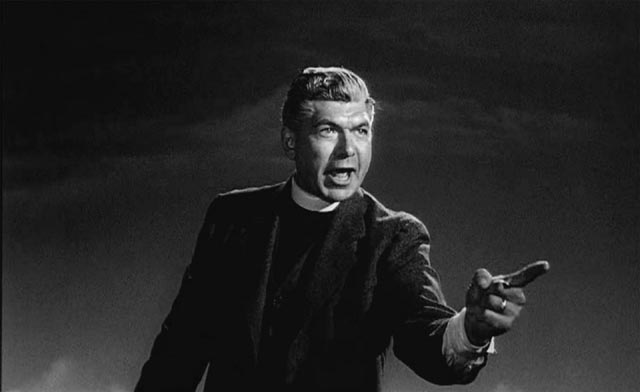
There are supplementary threads woven around the central conflict – Gene Kelly is on hand as cynical newspaperman E.K. Hornbeck (based on W.L. Mencken), whose paper has hired Drummond; Claude Akins is the local preacher who initiated the prosecution, and as the case proceeds is driven ever deeper into religious intolerance, culminating in his public condemnation of his own daughter (Donna Anderson) to Hell for siding with Cates, her fiance; while between Drummond and Brady stands the latter’s wife (Florence Eldridge), who tries to mediate between the pair as the legal fight pushes each of them deeper into their mutually hostile convictions.
But it is on the full-blooded performances of the two stars that the movie’s thematic strength and entertainment value rests; Tracy and March are steeped in the wit and charm which so often characterized the great stars of classical Hollywood and much of the viewer’s pleasure derives from the nuances of their interactions rather than the overt thematic intentions of the script. This, of course, is typical of Hollywood – the message is subsumed under the personal dramatic conflict. While the play was written towards the end of the Red Scare of the late ’40s and early ’50s and was intended as an argument against the McCarthy-ite assault on intellectual freedom, the film ends not so much with a resounding rejection of the rigidity of religious fundamentalism as with a plea for the peaceful coexistence of science and religion (more than a little reminiscent of the problematic ending of Fritz Lang’s Metropolis [1927] with its assertion that class conflict can be resolved by having the heart mediate between the brain of Capital and the hands of Labour).
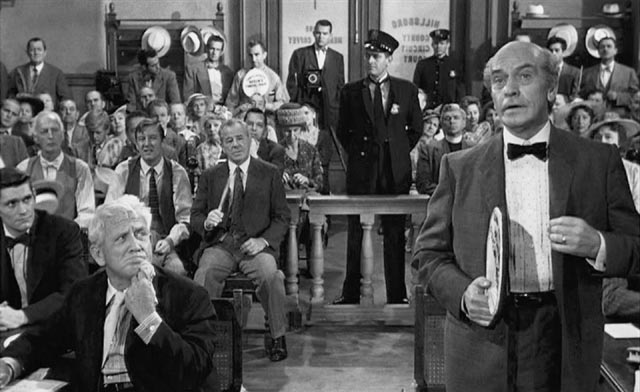
But, despite Kramer’s usual worthy and prominent liberal intentions, it is really the spectacle of Tracy and March playing off each other which makes the movie so enjoyable to watch. It reminds us that however psychologically plausible star performances might have been in classical Hollywood, they are first and foremost performances, constructed from a mixture of literary qualities and star personae. There is a certain artificiality which separates screen life from real life, which in itself provides much of the pleasure to be derived from watching the great studio movies (I never tire of the scenes between Humphrey Bogart and Claude Rains in Casablanca, although there is nothing “realistic” about them).
By the ’80s, though, after two decades during which classical Hollywood was systematically deconstructed, mere psychological plausibility was no longer enough; new ideas of screen realism had firmly taken hold (although a yet newer countercurrent which would restore much of the older artificiality had arisen in the late ’70s in the wake of movies like Star Wars). This new realism began as a deliberate effort to drag cinema closer to the political, social and emotional experience of the audience as these things were shaped by the great upheavals of the ’60s. “Realism” was perceived as a new kind of honesty about the harshness of the world – downbeat endings became common and movies were no longer seen (among certain segments of the industry and the audience) as mere entertainments designed to take the viewer briefly out of the stresses of real life.
In their different ways, the other three features already mentioned illustrate this attempt to reflect a more complicated, less comforting world. Stylistically, these films reveal less certainty than was inherent in the seamless craft of Hollywood tradition. Narratively, events and motivations become more ambiguous; they slip from the self-assurance of the modern to the insecurity of the postmodern. And yet, each takes a different approach to the existential questions they address.
*
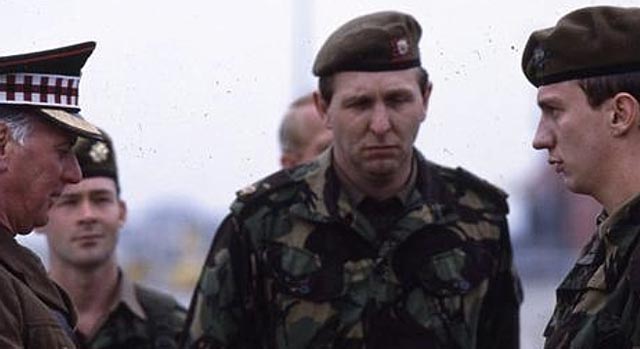
Resurrected (Paul Greengrass, 1989)
Paul Greengrass began his filmmaking career in documentary television and his breakthrough feature, Bloody Sunday (2002), is a superlative example of documentary reconstruction – in this case, the events of January 30, 1972, when a civil protest in Northern Ireland ended with the massacre of civilians by the British army, an event which triggered the increased violence of the Irish Republican Army through the ’70s and ’80s. Greengrass used familiar techniques – handheld cameras seemingly catching events on the fly – with precision and great dramatic effect. In his subsequent work, however, he has pushed the use of the tropes of cinematic “realism” to extremes of self-parody in the Bourne thrillers, where they serve exaggerated narratives more akin to comic book superhero stories than real life. I haven’t seen United 93 (2006), but Greengrass has come closest to recapturing the power of Bloody Sunday in his other two more recent based-on-real-incidents movies, Green Zone (2010) and Captain Phillips (2013), the former somewhat compromised by its generic ties to the Bourne movies (emphasized by the presence of Matt Damon as the lead), and the latter greatly enhanced by the remarkable and sympathetic performance of Barkhad Abdi as the Somali pirate in charge of the hijacking of an American ship.
But in the midst of his fifteen year television career, Greengrass made his first theatrical feature, Resurrected (1989), most notable for the breakout performance of David Thewlis as a soldier caught up in the Falklands war. Based on an actual incident, the film tells the story of Kevin Deakin, a young working class man ill-suited to military life, who gets disoriented and lost during a battle and is presumed dead. Having been honoured with a hero’s funeral, his reappearance weeks after the end of the war creates problems; his story of ending up far behind enemy lines in the confusion of the night battle, and of hiding out and scrounging for survival until he finally walks out of the mountains and makes his way to sheep farm fails to convince the military authorities. Accusations of cowardice and desertion make him a pariah, not only in his unit but also among his family and neighbours. A clean death is something everyone can cling to with reassurance; a compromised survival creates confusion and embarrassment.
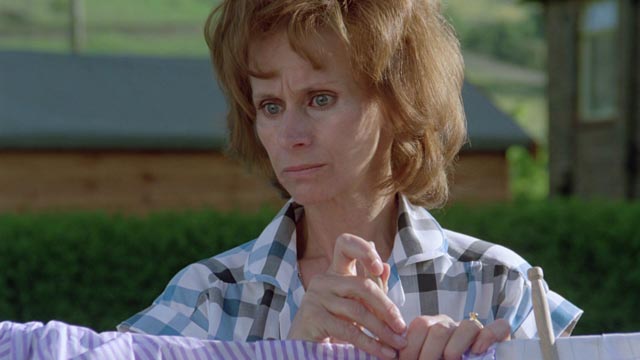
Although again rooted in the tradition of dramatic reconstruction of actual events, Resurrected is stylistically more straightforward than the later Bloody Sunday, closer to the naturalism of the British New Wave of the early ’60s, something which is heightened by the working class milieu – not to mention the presence of Rita Tushingham and Tom Bell as Kevin’s parents. But here Thewlis’ performance is stripped of the fierce certainty of an Albert Finney or a Tom Courtenay or a Richard Harris; the film refrains from making an unambiguous statement about what really happened to Kevin. In fact, it’s the uncertainty, the inability to find clarity in the chaos of battle and its effects on a frail human being, which is the film’s main theme. Those back home, civilians and military authorities alike, need to see a clearly delineated narrative which Kevin’s experience refuses to provide, while the other members of his unit see his escape from death as a kind of betrayal. Surviving war is deeply problematic and Kevin is ultimately subjected to brutal punishment for not having died.
Today, the concept (and effects) of post-traumatic stress are well-known; this was less the case even as recently as the early ’80s. Resurrected indicates that attitudes had changed little since the two world wars when soldiers were expected to suck it up and keep fighting no matter how much horror they had experienced and how battered their minds had been. The film is a plea for empathy at a time when it was still in short supply, and it is as powerful as it is largely because of the deep vulnerability of David Thewlis’ performance, an embodiment of confusion and emotional pain which is at times difficult to watch – and a precursor of the nightmarish torment he displayed four years later in Mike Leigh’s dark masterpiece, Naked (1993). This is acting of a very different kind from the sterling craft of Tracy and March, with the actor risking painful personal exposure without benefit of a literary safety net.
*
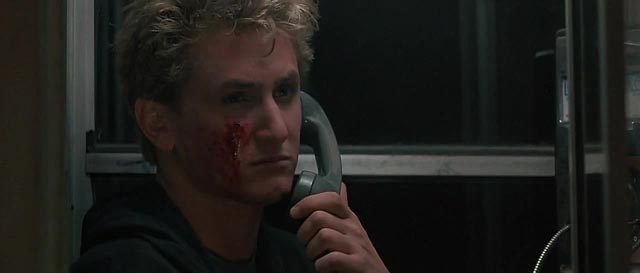
At Close Range (James Foley, 1986)
Naturalistic and psychologically nuanced performances are also the focus of James Foley’s second feature, At Close Range (1986). Of these recent Twilight Time disks this is perhaps the one I felt most ambivalent about. I hadn’t seen it before, but I had some sense of its reputation as a difficult and intense film, and also of Foley’s reputation as something of a stylist … yet beyond the performances (which are, of course, an indication of directorial skill as well as the innate talents of the cast), I found the film visually undistinguished. That is, except for several interludes where “style” becomes obvious to the detriment of the film’s naturalism. There are a number of montage sequences, characterized by slow-motion and set to Patrick Leonard’s very-’80s synth/piano score, like Brad Jr.’s first sighting of Terry in the town square at night which intercuts lingering shots of Brad Jr. watching her intently as he drives by with lingering shots in which the camera caresses her while the music adds a level of romantic longing which comes very close to bathos, if not outright parody.
These interludes interrupt what is generally a visually subdued naturalism, Juan Ruiz Anchia’s photography creating a palette of earth tones and flattened greens which emphasize the dullness and stifled potential of life in a rural area with few economic prospects for Brad Jr. and his younger half brother. Coming in the mid-’80s, At Close Range almost seems like a throwback to the ’70s, echoing the hopelessness of something like Mean Streets … a kind of “Mean Backroads”.
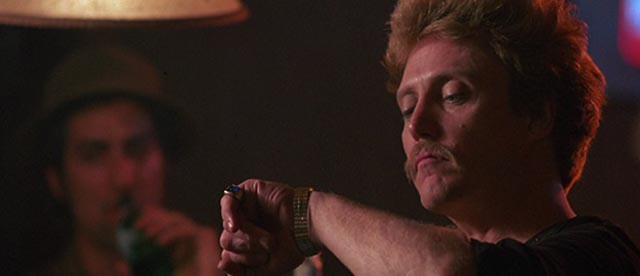
The heart of the story is Brad Jr’s (Sean Penn) desire to escape the limitations of his aimless life, living with his brother Tommy (Chris Penn), his mother Julie (Millie Perkins) and grandmother (Eileen Ryan, Sean and Chris’ actual mother). There are two potential avenues which open up for him, the first being Terry (Mary Stuart Masterson), an underage highschooler he becomes infatuated with. The second is reconnecting with his father, Brad Sr. (Christoper Walken), who has barely been present as he grew up and who occasionally drops by to leave a wad of cash for Julie. Brad Jr. is impressed by his father’s confident swagger and fast cars … and he’s also aware of Brad Sr.’s reputation as a local crime boss. In view of his limited job prospects, Brad Jr. is drawn to the idea of earning easy money by joining Brad Sr.’s gang, whose latest enterprise is stealing tractors from local farms.
His father’s gang isn’t too pleased at the idea of taking on the kid; they form an efficient unit and the new member introduces risks. But on his first job Brad Jr. proves himself worthy. It also makes him more ambitious and he quickly forms his own parallel gang with his buddies, managing to get arrested on their first job.
It isn’t long before Brad Jr. is faced with the reality of his father’s life; Brad Sr. proves to be a violent sociopath and Brad Jr.s attraction to what had seemed a glamorous outlaw life is replaced by revulsion and a desire to break away, to escape with Terry. Things spiral out of control; the emotional father-son ties prove to flow only one way as Brad Sr.s cold-blooded violence turns against his son and his friends. The film’s final act is a protracted and disturbing sequence of violent acts which shatter all of Brad Jr.’s illusions, finally enabling him to establish a more conscious sense of himself as an individual separate and apart from his father.
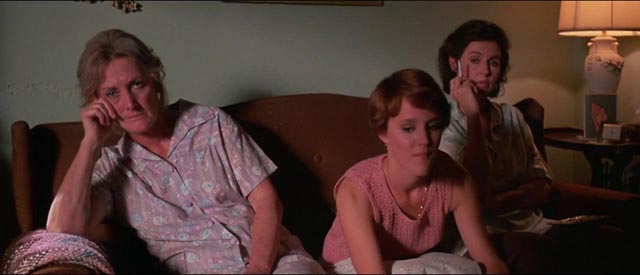
What makes this depiction of bleak lives and seemingly inevitable tragedy watchable is the cast, all of whom convincingly embody people who live precariously on the economic fringes of a society which has little need of them. Sean Penn, in his mid-20s, plays Brad Jr. with a seemingly calm surface through which we glimpse the inner pain and emotional longing of a kid who has grown up idolizing the father who essentially abandoned him. Christopher Walken, as that father, is chilling in the way he projects a surface charm beneath which coils the potential for monstrous violence. Walken is such a distinctive presence that his career is littered with moments in which his off-kilter personality disrupts and distorts the film surrounding him – sometimes to amusing effect (Communion [1989]), sometimes it seems more for his own amusement – but here he fits the character of Brad Sr. perfectly, providing a powerful object for Sean Penn to work against.
The rest of the cast is filled with fine character actors who give the film’s community a sense of realistic variety, from Brad Sr.’s gang – which includes Tracey Walter, David Strathairn, R.D. Call and J.C. Quinn – to Brad Jr.’s mirror gang – Kiefer Sutherland, Crispin Glover and Stephen Geoffreys. If the women fare less well, it’s because the world of the film is very much a masculine one, leaving the actresses more on the periphery, excluded to a degree from the emotional lives of the men and boys. The women are essentially powerless in the face of patriarchal authority, even though the patriarch is exposed as a monster. Mary Stuart Masterson, in only her second major role, despite essentially being an idealized dream object for Brad Jr., invests Terry with subtle emotions and a distinctive toughness which manages to aggravate Brad Sr. and his gang. Candy Clark has a brief but memorable role as Brad Sr.’s girlfriend, and both Millie Perkins and Eileen Ryan, although they exist only on the narrative’s edges, manage to suggest what amounts to an alternative parallel community which remains open to Brad Jr. even if he’s unable to comprehend it because of his desire to identify with Brad Sr.’s masculine swagger.
*
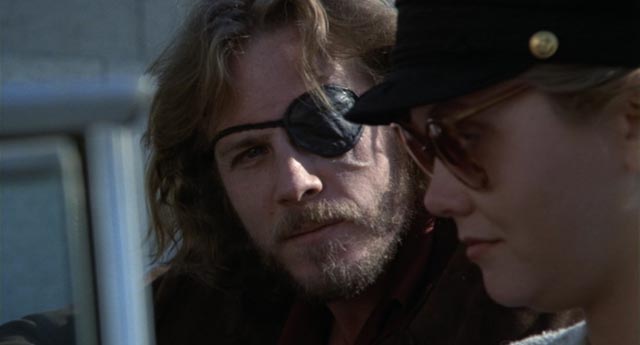
Cutter’s Way (Ivan Passer, 1981)
In contrast to the star focus of Inherit the Wind and the close examination of a single character in Resurrected, At Close Range has a strong ensemble out of which the two primary characters emerge. Although there are fewer characters in Ivan Passer’s Cutter’s Way (1981), these too work as an ensemble, with the three main characters complementing and contrasting one another within a pattern of complicated emotional and psychological states.
Ivan Passer was a member of the Czech New Wave in the mid-’60s, writing and directing one feature (Intimate Lighting [1965]) and co-writing two Milos Forman features (The Loves of a Blonde [1965] and The Fireman’s Ball [1967]) before the Soviet crackdown sent him into exile along with a number of other filmmakers. Passer was overshadowed by Forman when they both embarked on Hollywood careers, his films tending to be smaller and less successful commercially. Tonally, his work blended elements of comedy and drama in ways which weren’t typical of American films, and he showed an interest in moral ambiguity and crime as an expression of a reaction against social norms. After co-writing three features in the U.S. and directing a fourth from a Peter Stone script, Passer was hired to direct an adaptation of Newton Thornburg’s novel Cutter and Bone, written while the scars of Vietnam were still very fresh in the American psyche. The project was unlikely in a number of ways – the producer, Paul R. Gurian, had never made a feature; the writer, Jeffrey Alan Fiskin, had only one previous credit, a biker movie made a decade earlier; the director was a Czech exile, looking at this American story from an outsider’s perspective; and the three leads were not mainstream stars.
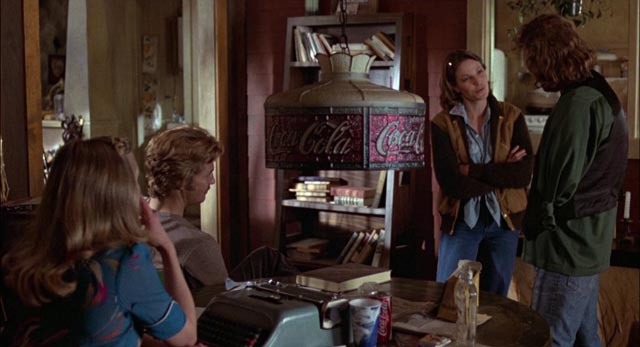
Cutter’s Way is a deceptive movie. On its surface, it’s the story of a clumsy attempt by a couple of friends to cash in on what may be knowledge of a crime committed by a prominent local Santa Barbara citizen. Richard Bone (Jeff Bridges) is a salesman for a boat company, working for another childhood friend, George Swanson (Arthur Rosenberg). He’s not as laid back as The Big Lebowski’s Dude, but his value to the company seems to reside more in his status as an attractive piece of beefcake who makes the boats look more appealing by his presence on deck. This role is as tawdry as it sounds; we first meet him in a motel room with a mature blonde (Nina van Pallandt) after what appears to be a mutually unsatisfying sexual encounter and as he leaves he basically asks her for gas money. He comes across as an unsuccessful gigolo.
Driving home, his run-down old sports car breaks down in an alley and as he tries to restart the engine, a big sedan pulls up nearby and a man places something in a dumpster. As Bone abandons his car and walks away, the camera reveals a pair of women’s legs sticking out of the trash. The next day, the police pull Bone in as a suspect in the murder because his car was found nearby. Lacking evidence, they release him. But then, while watching a parade with his friend Alex Cutter (John Heard) and Cutter’s wife Mo (Lisa Eichhorn), Bone thinks he recognizes the parade marshall, J.J. Cord (Stephen Elliott), as the man he saw in the alley. Cutter immediately hits on the idea of exposing Cord as the killer by attempting to blackmail him; if Cord coughs up the money, they can take it to the police as proof of his guilt.
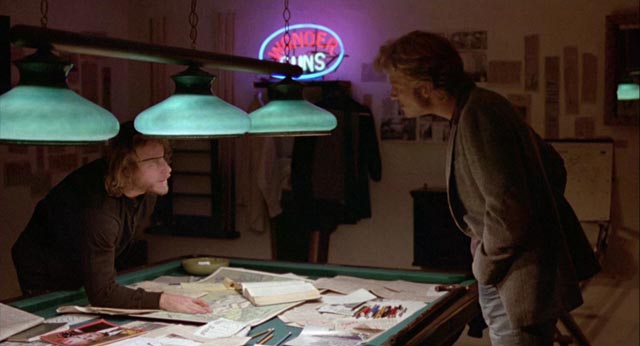
It’s a dumb plan which neither Bone nor Mo takes seriously. But Cutter is driven by a fierce anger and he’s looking for someone on whom to vent his rage. He’s a vet who lost an arm, a leg and an eye in Vietnam only to return to a country which doesn’t care, which in fact looks down on him. All of this is complicated by a network of social and familial connections going back to childhood, fuelling Cutter’s anger with an element of class resentment which makes Cord, a powerful man in the oil business, an ideal target.
The plan is additionally complicated by conflicted feelings between Bone and Mo; there was obviously something between them in the past, but she married Cutter instead and is now tied to a man consumed by his own deep physical and psychological injuries. She comforts herself by sinking into alcoholism, which Bone would like to save her from.
All the personal, social and class complications weave together around the foolish blackmail plan, dragging the three of them towards an inevitable tragic conclusion; once the scheme is set in motion, they’re all powerless to avert disaster. It’s as if these three see themselves as characters, acting out some kind of noir scenario (heightened by Jordan Cronenweth’s atmospheric photography) which assumes a self-fulfilling narrative trajectory which remains unresolved in an ambiguous conclusion; in trying to write their own story, Cutter and Bone are brought face to face with the powerlessness imposed on them by the very class structures they are trying to fight against.
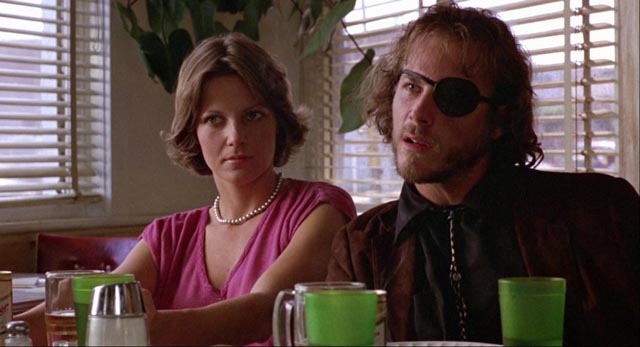
Apparently Bridges had originally wanted to play Cutter, but the part of Bone is well-suited to his personality, playing on an easy charm which can’t quite conceal his awareness of his own compromised morality. John Heard has had a very prolific career, but has never really become a star; his searing performance as Alex Cutter should have made him one, but no doubt it’s too dark and disturbing for the comfort of producers. He inhabits Cutter in the way Dustin Hoffman inhabited Ratso Rizzo in Midnight Cowboy, embodying the essence of the outsider driven to madness by his own anger. But the subtlest performance in the film comes from Lisa Eichhorn, who has also remained somewhat underrated since she first appeared in James Ivory’s The Europeans and John Schlesinger’s Yanks in 1979. There’s a heartbreaking delicacy in her performance here; she conveys remarkable depths of emotion, sadness, pain and despair with the slightest change of expression or a glancing look. This is film acting at its best, allowing the camera to catch the smallest passing detail and give it tremendous emotional weight.
Cutter’s Way had several strikes against it when it was released, none of which had anything to do with its intrinsic qualities. Apart from the fact that, by 1981, the mainstream audience wasn’t inclined to immerse itself in the psychic pain lingering from the Vietnam war, it got caught in the fall-out of United Artists’ post-Heaven’s Gate collapse, resulting in a limited, poorly handled release (initially under its original title, Cutter And Bone) and the first reviews were negative. By the time more considered and sympathetic reviews appeared, the film had been pulled from theatres. Re-released a bit later on the strength of those more positive reviews and under a new title, it still didn’t take off commercially and all but disappeared for more than thirty years. Emerging again now on disk, it deserves rediscovery and re-evaluation as one of the most distinctive films of its period and, through Ivan Passer’s foreign eyes, one of the most incisive dissections of the often hidden undercurrents of class in American society.
*
All four of these disks are up to Twilight Time’s usual standard, with excellent transfers and their signature isolated score tracks, accompanied by Julie Kirgo’s short but perceptive liner notes. Both At Close Range and Cutter’s Way include informative commentary tracks – the former featuring Nick Redman in conversation with director James Foley, the latter with Redman and Kirgo. Resurrected has a pair of interview featurettes, one with director Paul Greengrass, the second with actor David Thewlis. There are no supplements on the Inherit the Wind disk, which is a pity, as a commentary addressing the differences between the film and the play and the relationship of both to the actual Scopes trial would have been appreciated.
*
Still in the Twilight Time stack, waiting for when I have time to get to them: John Huston’s Moby Dick and Fat City; Noel Black’s Pretty Poison; Otto Preminger’s Bonjour Tristesse; Nicholas Roeg’s Eureka; Barbra Streisand’s Yentl; and five more recent acquisitions – Junya Sato’s Bullet Train; Michael Winner’s The Stone Killer (still hoping for Blu-ray releases of Winner’s Lawman[1] and The Nightcomers); Don Siegel’s Edge of Eternity; Mark Robson’s Peyton Place; and Roy Ward Baker’s Inferno … the latter in 3D, which I’ll be checking out soon at my friend Steve’s.
_______________________________________________________________
(1.) Twilight Time has just announced (June 19) that Lawman will be one of their September Blu-ray releases. (return)
Comments